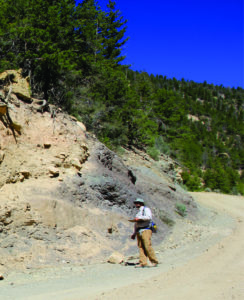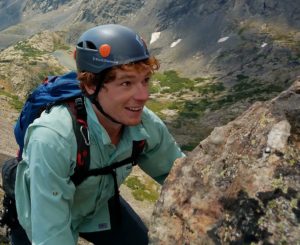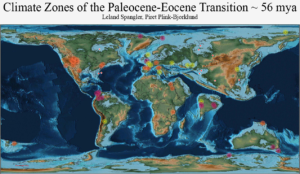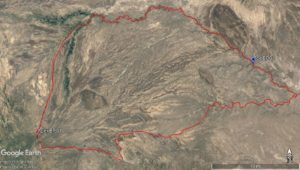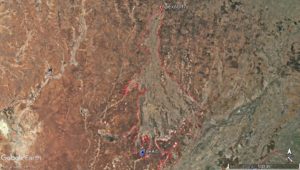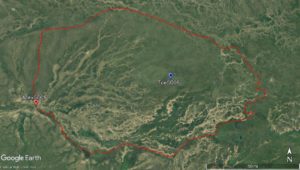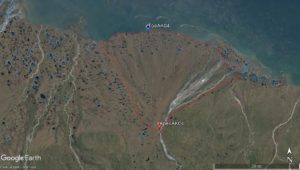People
PEOPLE
Here is some information about the current and previous research group members and their projects.
Current PhD students Current MSc students Current BsC students Current visiting scholars
Previous PhD students Previous MSc students Previous BsC students Previous post-docs and visiting scholars
CURRENT PhD STUDENTS
|
Mark Hansford Project: The effects of climate on fluvial discharge and the control on fluvial fans: A quantitative study
My research is the modern complement to the ancient outcrop work the rest of the research group is working on. It was born out of the observation that some fluvial formations in the rock record contain 90%+ upper flow regime sedimentary structures, leading us to ask the question, “What kind of rivers could make and preserve such deposits?”. For the first phase of my research, I looked at hundreds of rivers around the world and investigated how the discharge regime is controlled by a series of a series of different factors such as climate zones, drainage area, gradient, etc. We have currently submitted a paper entitled, “Quantitative analyses of global river discharge variability and hydrograph shape” to Earth Science Reviews, it is under revision and will hopefully be published soon. The second phase of my research is focused on examining the controls governing the formation, size, and architecture of fluvial fans. We are building off the new insights established in the first phase of my research and examining how different parameters such as climate zones and discharge variability control fans. We have presented on this work at AAPG, AGU, SEPM, GSA, and the 11th International Conference on Fluvial Sedimentology. |
B.S. in Geology from Wheaton College. Intern at Royal Dutch Shell summer 2018 and will be returning for a second internship summer 2019.
|
|
Dessy W Sapardina Expected Graduation 2021 Project: Supercritical flow signatures and erosional features in active margin basin floor fans The project aims to test whether the basin-floor fans consist of tabular sheet like beds as predicted by the models or rather consist of amalgamated lenticular bodies that indicate channels or scours. We hypothesize that erosional features due to channelization and supercritical flow are more common in basin-floor fans than predicted by current models. It is still unclear how common are supercritical flow turbidity currents and whether they occur on all types of continental margins. There are also contradicting opinions on whether the supercritical flow turbidity currents mainly occur on slopes or can also be common on basin floor. The preliminary results from the field work in basin floor fan Juncal formation, California suggest that Froude supercritical flow deposits are common. The erosion surfaces and the association of sandstone prone facies with the erosionally bound deposits suggest that the proportion of channelized deposits is high, and present even in outer-fan setting.
|
Education: MSc Colorado School of Mines, Golden, CO ; Bachelor of Engineering in Geological Engineering Gadjah Mada University, Yogyakarta, Indonesia Professional experience: Teaching Assistant for Multidisciplinary Petroleum Design Spring 2019, 2017; Field Assistant for Petroleum Engineer Field Camp Summer 2018, 2017 Yoga Teacher 2015 – 2016 ExxonMobil Oil Indonesia as Development Geoscientist 2012 – 2015 ExxonMobil Oil Indonesia as Exploration Geoscientist 2007 – 2015 Hobbies:Yoga and Mountain Biking “A geologist by education, a mother by nature and a yoga teacher by passion” Publications: The 20th 2018 International Sedimentological Congress (Quebec, Canada) poster presentation “Title: The Role of Froude Supercritical Flows and Sediment Transport on Deepwater Active Margin Basin Floor-fans, Juncal Formation, California” Outreach activity:
|
|
Haipeng Li Project: Environmental signal propagation, preservation, and identification
The goal of this project is to answer at least in part the following question: how can we interpret the ancient sedimentary record with more confidence and less biases? This is a big question and can be further investigated from three different aspects. Autogenic processes: What are autogenic processes indeed? Are they noises or do they contain value information about past environmental conditions? Short answer: autogenic processes are not auto per se. They are responses to external inputs and may record valuable information about past environmental conditions. Signal: What is a signal? How can we characterize a signal? What controls the propagation of signal and its time lag? What is the role of discharge variability? How about its preservation and identification? Short answer: a signal of water and sediment discharge conditions is a change in such conditions. A signal can be characterized from different aspects, such as its duration, its magnitude, etc. Discharge variability is one important control on signal propagation, and it can facilitate signal propagation in many cases. Autogenic processes have a major role in the preservation and identification of signals. Interpretation: Is there any unequivocal evidence that can link measurable changes in the strata to changing environmental conditions? How can signals be related to environmental conditions? Apart from a multiple-hypotheses working method, what can we do to reduce the risk of confirmation bias and overconfidence in the interpretation? Short answer: Be open minded and willing to change hypotheses. To quote Karl Popper: “… whenever we propose a solution to a problem, we ought to try as hard as we can to overthrow our solution, rather than defend it.”
|
Ph.D. in Geology, Colorado School of Mines, in progress. M.S. in Sedimentology, China University of Geosciences, Beijing, 2015 B.S. in Geology, China University of Petroleum, Beijing, 2012 Anything fun:
|
|
Bryan McDowell Project: Biostratigraphy of the upper Mancos Group and Mesaverde Group, Piceance basin, Colorado
The Mesaverde Group in western Colorado is a significant natural gas reservoir, producing from isolated-to-amalgamated fluvial sandstones encased in floodplain muds and sourced by laterally- and vertically-adjacent coals. The Mesaverde Group, and the Piceance Basin in general, has been the subject of tight-gas sand research for decades through collaboration between industry, government, and academia. Past research has focused on discrete stratigraphic intervals, small geographic areas, and lacked subsurface-to-outcrop integration. Additionally, previous studies lack robust data sets for subsurface correlation in these laterally heterogeneous reservoirs. The objectives of this study are: (1) constrain and correlate the Williams Fork Formation with a basin-scale stratigraphic framework based on marine transgressions and regressions; (2) characterize fluvial sandbodies at reservoir-scale along the Grand Hogback; and (3) determine allogenic and autogenic controls on sedimentation. |
|
|
Project: Tide-Dominated Delta Sedimentary Characteristics and Field Work Application
Facies and sedimentary characteristics of tide-dominated and -influenced deltas vary significantly. This leads to the question of how to accurately recognize one in the field. My aim is to gather sedimentary characteristic data for each subenvironment on as many interpreted tide-dominated and -influenced deltas as possible. I then analyze the dataset looking for common characteristics and learning where the knowledge gaps are. This paper is currently in progress and preliminary observations suggest, while there is significant inconsistency in the language used to describe these deltas there are also many common sedimentary characteristics that are used to justify significant tidal action. The goal is to use this data and the lessons learned to approach outcrop analysis and interpretation more quantitatively. I plan on applying these methods to the Hygiene sandstone in the Denver Basin. This is an Upper Cretaceous isolated sand body. Based on previous research done by Louise Kiteley and discussions with my advisor Dr. Plink-Bjorklund my initial hypothesis for this research is a tide-dominated delta interpretation. The debate surrounding isolated sand bodies is fierce, and I hope that this approach will force me to be as objective as possible. Paper in Progress: Sedimentary Characteristic Distribution Within Tide-Dominated and -Influenced Deltas; A Literature Review |
Education: B.S. in Geology from Southern Methodist University ‘14 Hobbies: Rock Climbing, Mountaineering, Skiing, Carpentry, Travel Family: Wife – Mackenzie Genecov; Dogs – Buffy and Pierre |
|
Andrew Heger My research focuses on forebulge and backbulge deposition zones in both modern and ancient foreland basin systems (FBS). The forebulge depozone is fairly well represented in literature, whereas the backbulge has received far less attention. The aim of this research is to provide both a historical perspective on the forebulge-backbulge research, and provide an update on the current state of knowledge associated with these parts of the FBS. Presently, I’m working on documenting the criteria for how these areas have been recognized and what evidence has been used to support their recognition. |
MS Geology: Colorado School of Mines, 2016 PhD Geology: Current Student Work Experience: 2010-present: Oil and gas industry Personal: Besides spending time with my family and friends, I enjoy organizing & leading multi-day river trips across the western U.S. |
CURRENT MSc STUDENTS
|
Michael Peffer Project: Documenting the Development of a Forearc Basin:
Upper Cretaceous Hornbrook Formation Near Hilt, Northern California
|
|
CURRENT BSc STUDENTS
CURRENT VISITING SCHOLARS
|
Xuan Yang Project: Effects of fan-delta sedimentary characteristics and evolution process on the basin geomorphology in the Lower Cretaceous Prosopis Formation of the Bongor Basin, Chad
The main objectives of this study are:(i) to analyze the sedimentary characteristics and evolution processes of fan-deltas in Bongor basin under different tectonic setting; (ii) to discuss the relationship between the fan-delta processes and basin morphological evolution; (iii) critically evaluate existing models for fan deltas. Compared with the normal deltas, fan-deltas have quite differences in the controlling factors, internal architecture and evolution processes and how does the fan deltas influencing basin geomorphology are also different. Still, marine basins are greatly different from lacustrine basins in sediment partitioning, which shows that the controlling factors for the development and evolution of lacustrine fan-delta should be further explored
|
Xuan Yang received his bachelor degree in 2012 from Southwest Petroleum University in China. He has worked in the Sixth Oil Production Plant of PetroChina Daqing Oilfield Company for 1 year. He continued his research and received the master degree in 2016 from China University of Petroleum (Beijing). He had an internship in Research Institute of Petroleum Exploration and Development in PetroChina Huabei Oilfield Company from 2014 to 2016. He continued his research and studies at China University of Petroleum (Beijing) as a PhD candidate since 2016. He is actively working on sequence stratigraphy, sedimentology and reservoir analysis of clastic rocks. |
PREVIOUS PhD STUDENTS
|
Kristi Zellman My doctorate thesis research is focused on Paleogene deposits in the San Juan Basin (SJB), New Mexico. The SJB is thought to preserve the southwestern-most terrestrial sedimentary record of late Paleocene and early Eocene in North America. In recent years, Paleocene-Eocene (P-E) boundary deposits have been a focus of research due to the discovery of globally-distributed anomalous sedimentation events coincident with periods of geologically abrupt global warming (hyperthermals), including the Paleocene-Eocene Thermal Maximum (PETM). Nevertheless, the SJB was previously overlooked as a possible dataset for this research, in part due to a long-standing suggestion that the P-E boundary falls within an unconformity. However, similarities between the SJB deposits and anomalous sedimentation events in other terrestrial basins associated with early-Eocene hyperthermals have led myself and a few other researchers to question the chronological placement of the unconformity. My research is part of an ongoing investigation of these deposits with goals to (1) refine the chronostratigraphy of the P-E boundary and determine whether records of early-Eocene hyperthermals, including the Paleocene-Eocene Thermal Maximum (PETM) are preserved, and (2) describe climatic conditions and their impact on fluvial sedimentation. Preliminary results show similarities between the P-E fluvial deposits in the SJB and seasonally variable discharge river systems that receive most of their annual (or in some cases, interannual) precipitation from one to a few large downpours. Furthermore, the large spatial extent, downstream sedimentological trends (decreasing degree of channel amalgamation, decreasing channel size, decreasing grain size, and increasing percentage of floodplain deposits), and evidence of channel avulsions are consistent with a large fluvial fan system. Observed vertical sedimentological trends suggest multiple cycles of fan progradation through the study interval. Initial results from carbon isotope analysis suggests that the cycles of fan progradation may be tied to hyperthermal events that are characteristic of the earliest Eocene. These results, combined with limited biostratigraphic data, suggest that the SJB may provide an additional source of proxy data for early Eocene hyperthermal research. |
|
|
Matthew Belobraydic
|
|
PREVIOUS MSc STUDENTS
PREVIOUS UNDERGRADUATE STUDENTS
|
Leland Sprangler Project: PETM Climate Types
Recently, Leland has been investigating rapid climate change during the Paleocene-Eocene Thermal Maximum, and its signatures left in the rock record worldwide. This research aims to provide a comprehensive overview of existing PETM literature, a categorization of PETM climate types, and a visual display of these climate types to identify trends and gaps in the dataset. He has had the opportunity to assist PhD candidate Kristine Zellman with her PETM work in the San Juan Basin, and is looking to continue with his own studies in graduate school. Currently, Leland is writing his own paper to synthesize his investigations in to PETM climate types. |
B.S. in Geological Engineering (Exploration) 2019 Leland is a senior undergraduate student interested in sedimentology, paleoclimate, and stratigraphy. He is looking foreword to interning with EOG Resources as a geology intern starting in the summer of 2019, and is looking to start a M.S in the fall of 2019. Previously, Leland has worked as a geology museum tour guide, and as a geological engineering intern with the Colorado Department of Transportation. In his copious spare time, Leland is an avid snowboarder, mountain biker, and fly-fisherman. He also enjoys playing blues guitar with his band. |
|
Julia Payne Project: Scaling relationships in modern fluvial fans – implications for climatic vs, tectonic controls on the formation and size of fluvial fans
Text of abstract: Is the size of fluvial fans controlled by the tectonic setting they occur in or their climatic setting? The process of fan formation is imperative to understand as it has implications for a multitude of other disciplines beyond sedimentology, including flood prevention, reservoir characterization, and paleoclimate modeling. Currently, there is not an extensive interpretation of the controls behind fluvial fan formation, size, or internal architecture. Fans have been investigated individually, but the first order controls on the formation and preservation of fluvial fans are not fully understood. Here, to address this issue, we used satellite imagery from Google Earth to measure the outlines of the 415 fluvial fans identified by Hartley et. al (2010). We also measured channel width at the apex and toe of each fan and calculated the gradient. For each fan, the tectonic and climatic setting was identified. We investigated the scaling relationships between these variables and are accessing possible trends and controls exerted by the tectonic and climatic settings. Early results indicate that fan sizes may be controlled by a combination of both the tectonic and climatic settings. Careful investigation will be needed to further decipher the validity of this result, and to eliminate commingled controls.
|
|
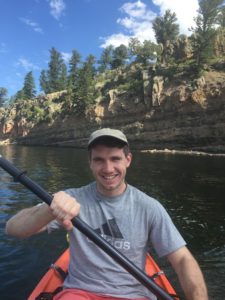
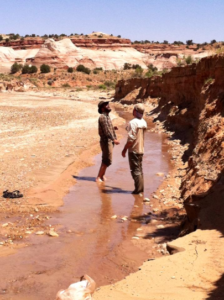
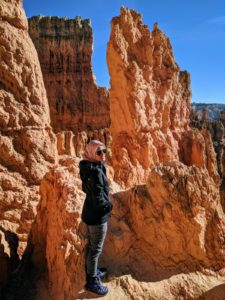
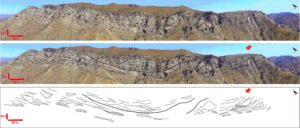
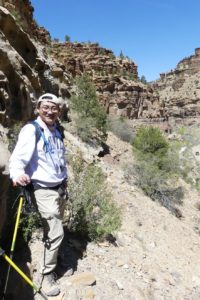
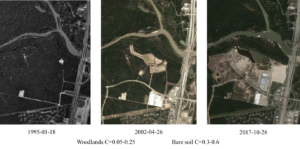

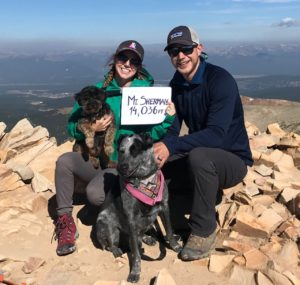
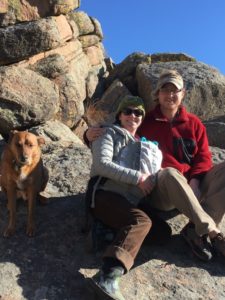
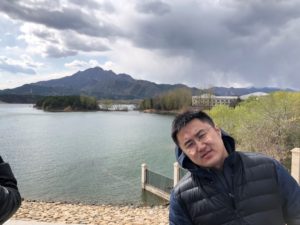
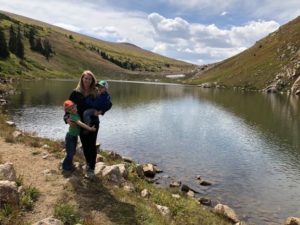
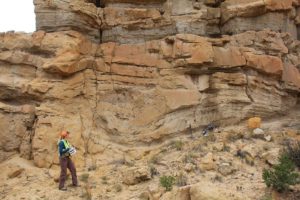 I
I